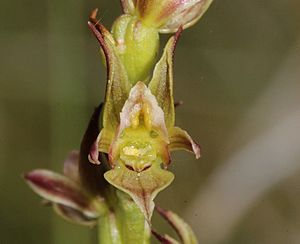Maroon leek orchid facts for kids
Quick facts for kids Maroon leek orchid |
|
|---|---|
 |
|
| Prasophyllum frenchii growing in East Gippsland | |
| Conservation status | |
| Scientific classification |
The maroon leek orchid, also called the swamp leek orchid, is a special type of orchid. It only grows in south-eastern Australia. This plant has a single green leaf shaped like a tube. It can have up to 65 flowers that are green, reddish-brown, or red. This orchid used to be found in many places. Now, fewer than 1,000 plants are left in only seven small groups.
What it Looks Like
The maroon leek orchid is a plant that grows from an underground tuber, which is like a small storage organ. It is a perennial plant, meaning it lives for more than two years. It is also deciduous, so its leaves might die back at certain times.
It has one tube-shaped leaf that can be up to 200 mm (about 8 inches) long. This leaf is about 5 to 10 mm (0.2 to 0.4 inches) wide at its base. Often, the leaf has dried up by the time the plant flowers.
The plant grows a tall stem, usually 150 to 600 mm (6 to 24 inches) high. On this stem, you can find between 20 and 65 flowers. These flowers have a nice smell. They can be green, reddish-brown, or red. Like other orchids in its group, the flowers are upside down. This means the labellum (a special lip-like petal) is above the column (the part that holds the pollen) instead of below it.
The top petal, called the dorsal sepal, is egg-shaped and 5 to 8 mm long. The two side petals, called lateral sepals, are lance-shaped and also 5 to 8 mm long. They usually stay close together. The other petals are oblong, about 6 to 7 mm long, and point forward.
The labellum is egg-shaped and can be green or reddish. It is about 5 to 6 mm long. This part of the flower bends upwards about halfway along its length. The tip of the labellum is shaped like a triangle, and its edges are a bit crinkled. In the middle of the labellum, there is a raised, horseshoe-shaped area called a callus.
These orchids usually flower from October to November.
How it Got its Name
The maroon leek orchid was first officially described in 1889. A scientist named Ferdinand von Mueller gave it the scientific name Prasophyllum frenchii. He published this description in a magazine called The Victorian Naturalist. The plant was found by a young collector named "G. French." The name frenchii was given to honor him.
Where it Lives
The maroon leek orchid is found across a wide area, but it is very rare. It grows in south-eastern Victoria and the south-east of South Australia. You can find it in different places like grasslands, heathlands (areas with small shrubs), and open forests.
Protecting this Orchid
Records show that there used to be many thousands of maroon leek orchids. They were found as far east as Mallacoota in East Gippsland. Today, it is protected in Wilsons Promontory National Park. However, it has likely disappeared from areas east of the park.
Now, only about 250 to 750 plants remain in just seven small groups. Because of this, the species is listed as "Endangered" by the Australian government under the Environment Protection and Biodiversity Conservation Act 1999. It is also considered "Threatened" in Victoria and "Endangered" in South Australia.
The biggest dangers to this orchid are:
- Grazing: Animals eating the plants.
- Weed invasion: Other plants growing and taking over its space.
- Inappropriate fire regimes: Fires happening at the wrong times or not happening when they should, which can harm the plants.


